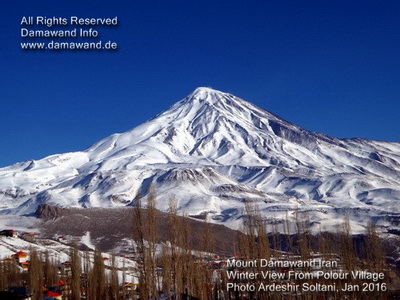Damavand Forecast
- Related topics: Damavand Trekking Season |
Damavand Ski Season |
Damavand Winter Warning
Damavand Weather
Mount Damavand Weather ForecastWeather Forecast for Trekking and Ski Touring Mount Damavand, Iran. In this page you have access to real-time weather information. However, you will find some general information about the Damavand climate and weather patterns in the Mount Damavand region.
Mount Damavand Summit Forecast
Weather Forecast for Mount Damavand Peak at 5670 meters altitude.By Snow-Forecast
6 Day Weather Forecast for Mount Damavand Iran at 5670 m altitude.
By Snow-Forecast.com
Weather forecast for Trekking Damavand
Why checking the forecast before a trekking tour to Damavand is important?Checking the weather forecast is an essential part of Damavand guided trekking tours. It can help you stay safe, avoid hazards, and make the most of your trekking experience.
Looking up the weather forecast before a Damavand tour is crucial for several reasons. Firstly; Damavand is the highest peak in Iran and its weather can change rapidly and unexpectedly. Knowing the weather conditions in advance can help you prepare adequately for the trek, such as packing appropriate gear and clothing for the conditions you may face.
Secondly; the weather on Damavand mountain can be extreme and dangerous, especially during the winter season. Heavy snowfall, strong winds, and low temperatures can pose a serious risk to your safety. By checking the weather forecast, you can avoid trekking during hazardous conditions and plan your trek accordingly. Thirdly; checking the weather forecast can also help you plan your trekking itinerary better. If the forecast predicts unfavorable weather conditions during the day you planned to trek, you may choose to adjust your plans to avoid risking your safety or missing out on the best views.
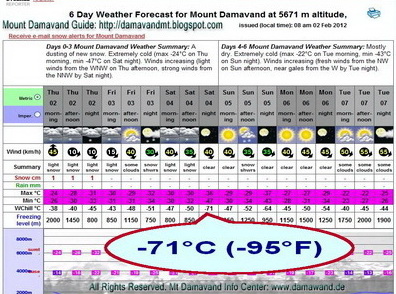
View Original Size Image
Mt Demavand, Iran Freezing Winter Temprature
Damavand Wind Chill -71° Celsius (-95° Fahrenheit) 4 February 2012
Damavand Meteo By Snow Forecast
Checking the weather forecast before trekking Damavand is important to ensure your safety, to be prepared for any conditions you may face, and to plan your trekking itinerary effectively.
There are a few more reasons why checking the weather forecast before trekking Mt. Damavand is important. Visibility; the weather can greatly affect visibility on the mountain. If it's foggy or cloudy, it can be difficult to navigate the terrain and find your way. Checking the weather forecast can help you plan for any visibility issues and make sure you have the necessary equipment, such as a map and compass, hand-held GPS to navigate safely.
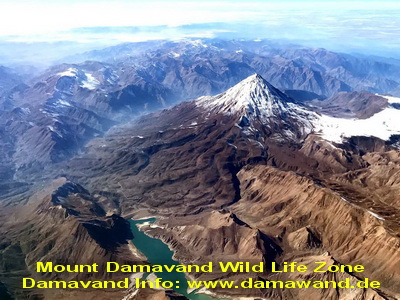
Mount Damavand Ecosystem Meteo
Snow field crossings; In winter, there are several snow crossings area on the Damavand trek, and the weather can affect the snow levels and avalanches. If it has snow recently or there's a forecast for snowfall, the snow levels may be higher and more difficult to cross. By checking the weather forecast, you can plan your route accordingly and avoid crossing snow fields during hazardous conditions.
Altitude sickness; the Damavand weather can also affect altitude sickness (AMS). If it's hot and sunny, you may be more likely to get dehydrated and experience symptoms of altitude sickness. On the other hand, if it's very cold, you may need to take extra precautions to prevent hypothermia. Checking the weather can help you prepare for any weather-related risks and take appropriate measures to prevent altitude sickness.
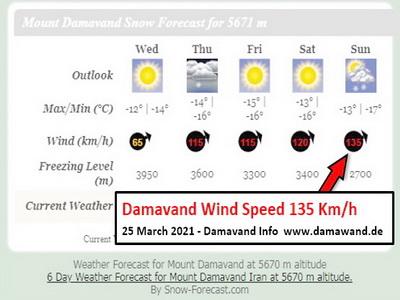
Demavand Strog Wind
Damavand Wind Speed 135 Km/h (84 Mile/h) 25 March 2021
Damavand Weather Forecast By Mountain Forecast
The term "wind chill" refers to the sensation of air temperature on human skin caused by the interaction of Damavand cold temperatures and winds blowing on exposed flesh. Simply said, the colder it will feel on your skin if you're outside the colder the air temperature and the greater the wind velocity.
Damavand Climate
Mount Damavand is located in the Alborz mountain range in northern Iran and is the highest peak in the Middle East, with an elevation of 5,670 meters (18,600 feet). The climate in this region is generally cool and dry, with cold winters and mild summers. During the winter months, temperatures drop below freezing, and heavy snowfall is common, making it difficult for Mount Damavand trekking tours.
The best time to climb the mountain is from late spring to early fall when the Damavand weather is milder, and the snow has melted. However, even during this time, temperatures can vary widely, and it is important to check the weather forecast before attempting the climb. It is recommending to check a reliable weather forecasting website or app to get the most up-to-date and accurate weather information for the Mount Damavand region.
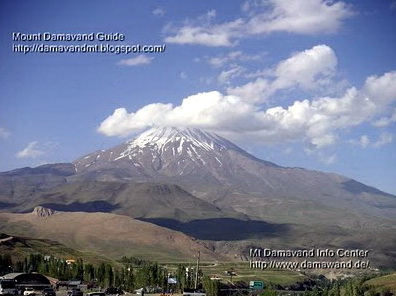
Mount Damavand Iran
Summer Season
Weather Forecast for Mount Damavand, Iran
The weather in Damavand can be severe, with lows below zero and strong winds at higher altitudes. It is essential that climbers carefully plan their ascent and be ready for unforeseen weather changes. Depending on the time of year and altitude, Damavand weather can change dramatically. Here are some details on the weather you may anticipate in Damavand.
Damavand Mountain is the highest ski resort in the middle-east and is a popular target for winter sport activities. Snow covers the entire Mount Damavand in winter and the upper parts and slops in spring and autumn. Damavand Summit is snow-capped several months a year. Ice and hardened-snow remain all the year on the north face glaciers called Sioleh and Dobi Sel, the north east glacier Yakhar and also the south route Icefall called Abshar Yakhi.
Temperature: Depending on the season and altitude, the climate on Damavand can range from extremely cold to warm. At lower elevations and in the Damavand Camp, temperatures can be more comfortable. At the top, temperatures can dip to -70°C (-95°F) or lower.
Precipitation: Snow, which can fall from October to May, makes up the majority of the mountain's precipitation. The mountain is often dry and sunny during the summer. See also Climate of Damavand.
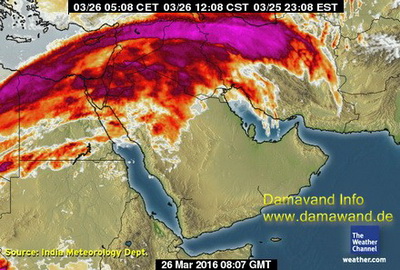
Cloud Pattern Iran & Mount Damavand
Heavy Cloud Cover, Heavy Showers and Snowfall Forecast Damavand Mountain
Meteo Damavand Iran, Cloud Pattern, Rain and Snow Forecast, 26 March 2016
By India Meteorology
Wind: Damavand frequently experiences wind, especially at higher altitudes. In the winter, winds can gust up to 135 km/h (84 mph), which makes ascending in Damavand more challenging and hazardous.
Cloud cover: On Damavand, cloud cover can sometimes be a problem, particularly in the winter when Damavand clouds can reduce vision and make climbing more difficult.
Weather patterns: The Siberian high pressure system in the winter and the Mediterranean in the summer both have an impact on the weather of Damavand.
Whether for Damavand Trekking
The optimum time to visit Damavand depends on your preferences and goals. The best time to reach the summit is during the summer. The best months to climb Mount Damavand are July and August because of the moderate weather, snow-free routes, and convenient access. Yet, this time of year can also be crowded.
Mt Damavand Camp3
Weather Forecast for Damavand Camp 3 Bargah Sevom 4220 m6 Day Weather Forecast for Mount Damavand at 4250 m altitude.
By Snow-Forecast.com
Winter is excellent if you wish to ski or engage in technical mountaineering. In general, the weather might be good for Damavand Ski Touring from November to March.
Damavand Mountain is the highest ski resort in the middle-east and is a popular target for winter sport activities. Snow covers the entire Damavand in winter and the upper parts and slops in spring and autumn. Damavand Summit is snow-capped several months a year. Ice and hardened-snow remain all the year on the north face glaciers called Sioleh and Dobi Sel, the north east glacier Yakhar and also the south route Icefall called Abshar Yakhi.
Mt Damavand Winter Warning
Warning For Winter Climb and Ski MountaineeringRemember weather condition at Mount Damavand could change to disastrous in winter season, with strong winds reaching more than 100 km/h ( 62 m/h) and freezing temperature dropping down to below -70° Celsius (-94 Fhrenheit) at the summit, you must be well-equipped and well-experienced for such a difficult climb and ski mountaineering expeditions in harsh climate and further more remember that rescue and medical facilities are not available in the area and in case of injury and emergency you need a good luck for surviving, so extra care should be taken for climbing and ski touring in winter and it is done by your own risk.
Read also Disclaimer.

Mount Damavand Winter Weather Forecast
Mount Damavand Weather FAQs
Q: What's the current weather on Mount Damavand?
A: The weather on Damavand Mountain can be cold due to its high elevation. You can check online or local sources like Damavand Forecast for updates on temperature, wind, and other factors.
Q: When is the best time to climb Mount Damavand in Iran?
A: The best time is during summer (June to September) when skies are clear and there's less snow on trails.
Q: What's the weather like at the Mount Damavand Peak?
A: It can be harsh and unpredictable, even in summer. Be ready for temperature drops, strong winds, and sudden changes. Check forecasts and have proper gear for safety.
Q: Is it safe to climb Damavand in a specific month/season?
A: Summer is generally safer, but experienced climbers also go in spring and early autumn. These times are more challenging due to harsher conditions and more snow.
Q: How cold does it get on Damavand Mountain?
A: It gets very cold, especially higher up. In summer, temperatures at the top can be freezing, so bring warm clothing.
Q: What's the average temperature on Damavand Mountain?
A: It varies with the season and altitude. In warmer months, it's around 10-15°C (50-59°F) at lower elevations. At the summit, it's -5°C to -10°C (23°F to 14°F) in summer.
Q: Are there warnings for climbing Damavand Volcano?
A: Depending on the weather, there might be advisories. Check alerts from local authorities or climbing groups. Read about winter warnings.
Q: How much snowfall can I expect on Damavand Peak?
A: Snowfall varies by year and season. Winter has heavy snow, and even in summer, higher parts might have snow. Be ready for snowy terrain.
Q: What's the weather forecast for the next week on Mount Damavand?
A: Check reliable online platforms or local sources for accurate forecasts. Weather can change fast, so stay updated for your climb.
Q: Are there challenges related to weather when climbing Mount Damavand?
A: Yes, challenges include quick weather changes, strong winds, cold temps, and snow/ice, especially higher up. Proper preparation and gear are vital for a safe climb.
Damavand Guide
Best source of information for trekking and ski touring to Mount Damavand.This post is very useful: Damavand Weather.
Find useful info: Damavand Info.
